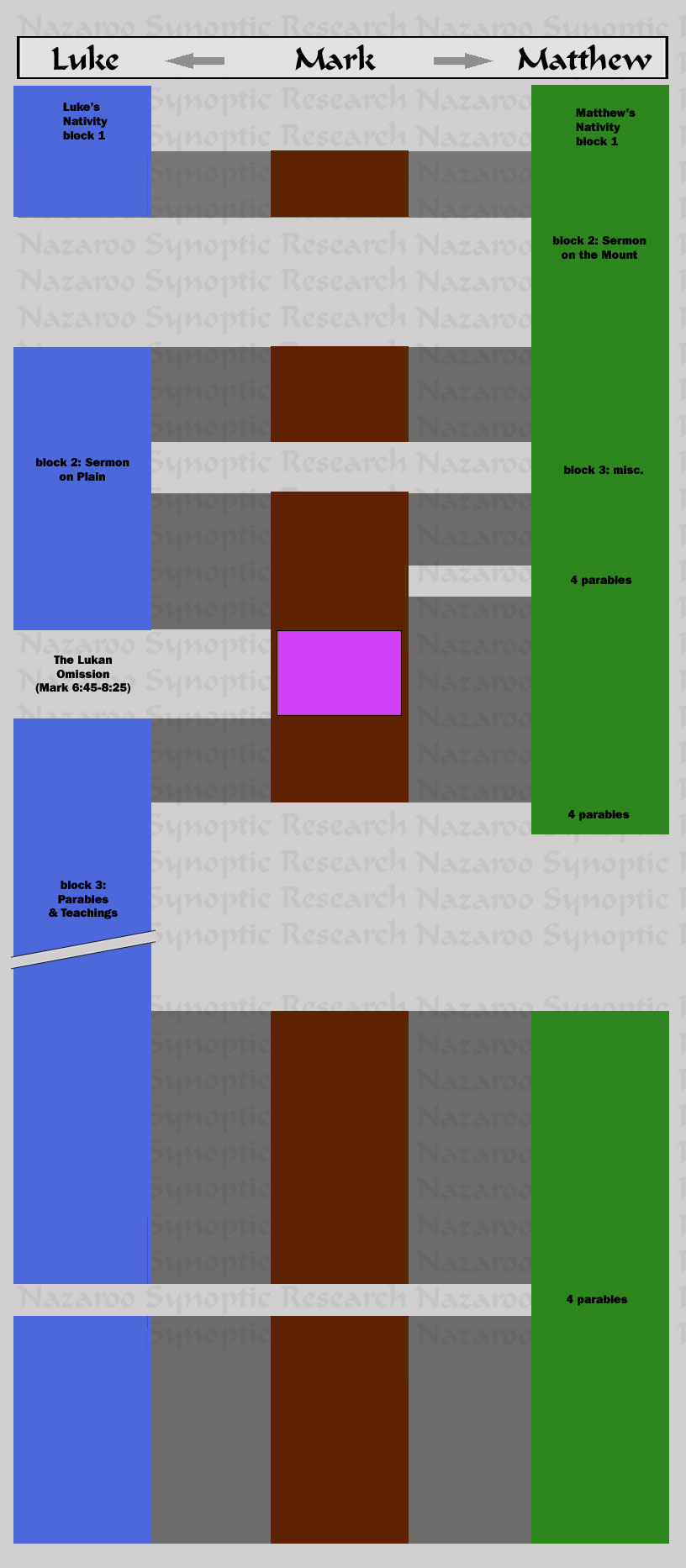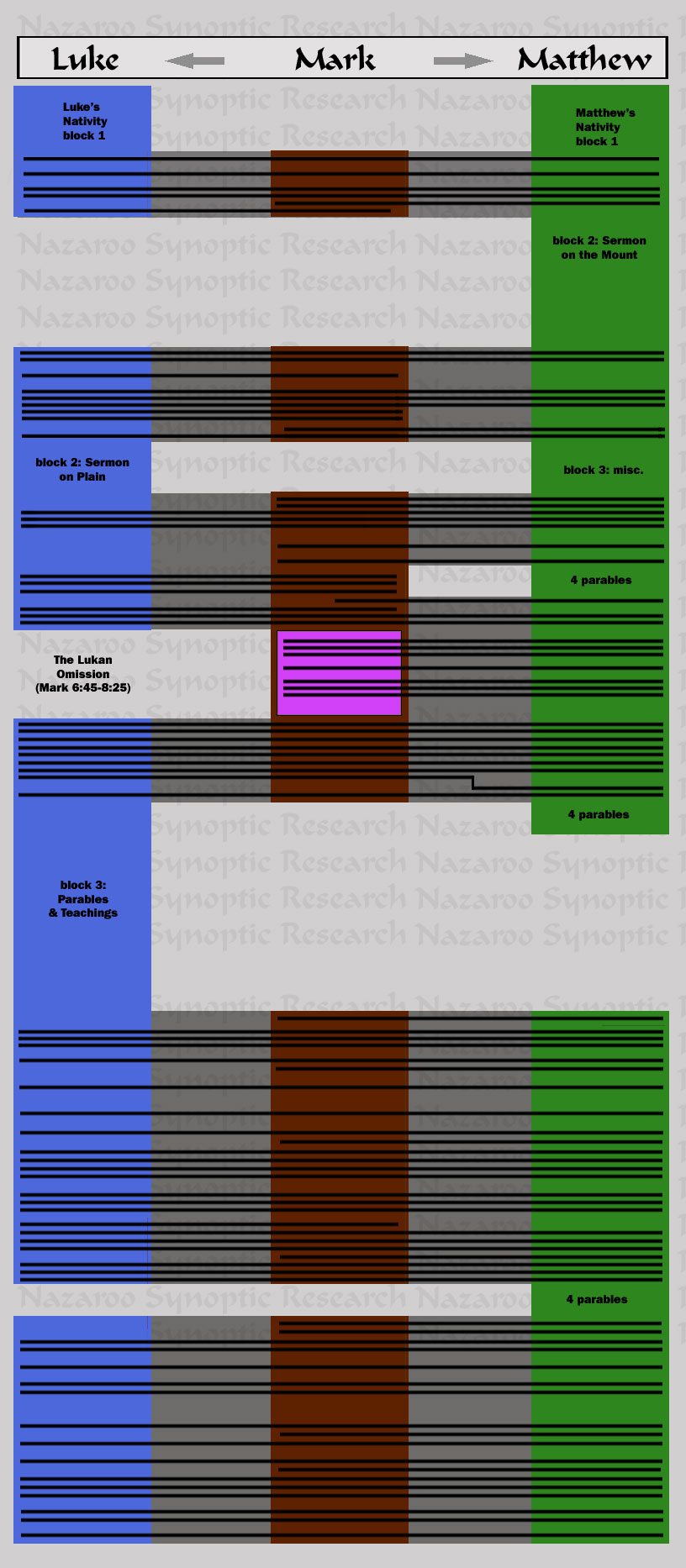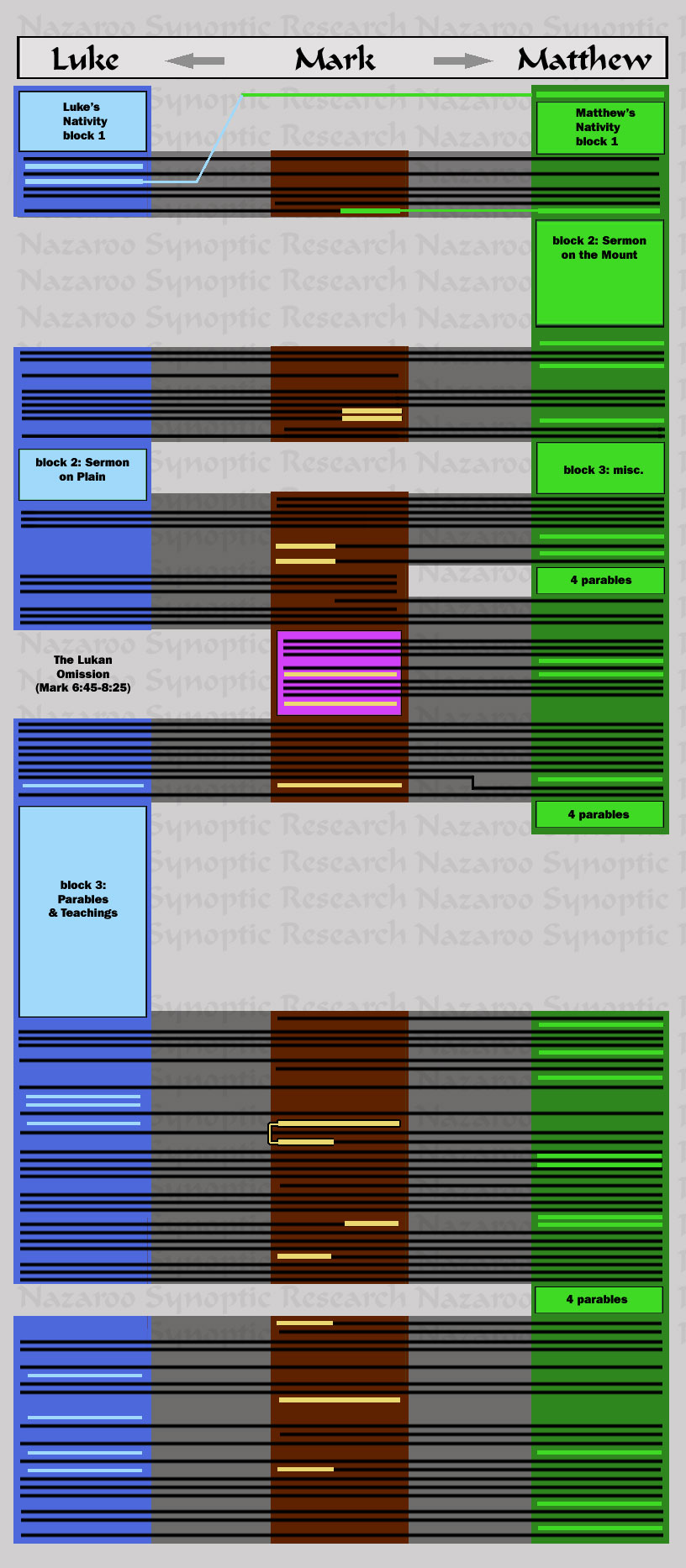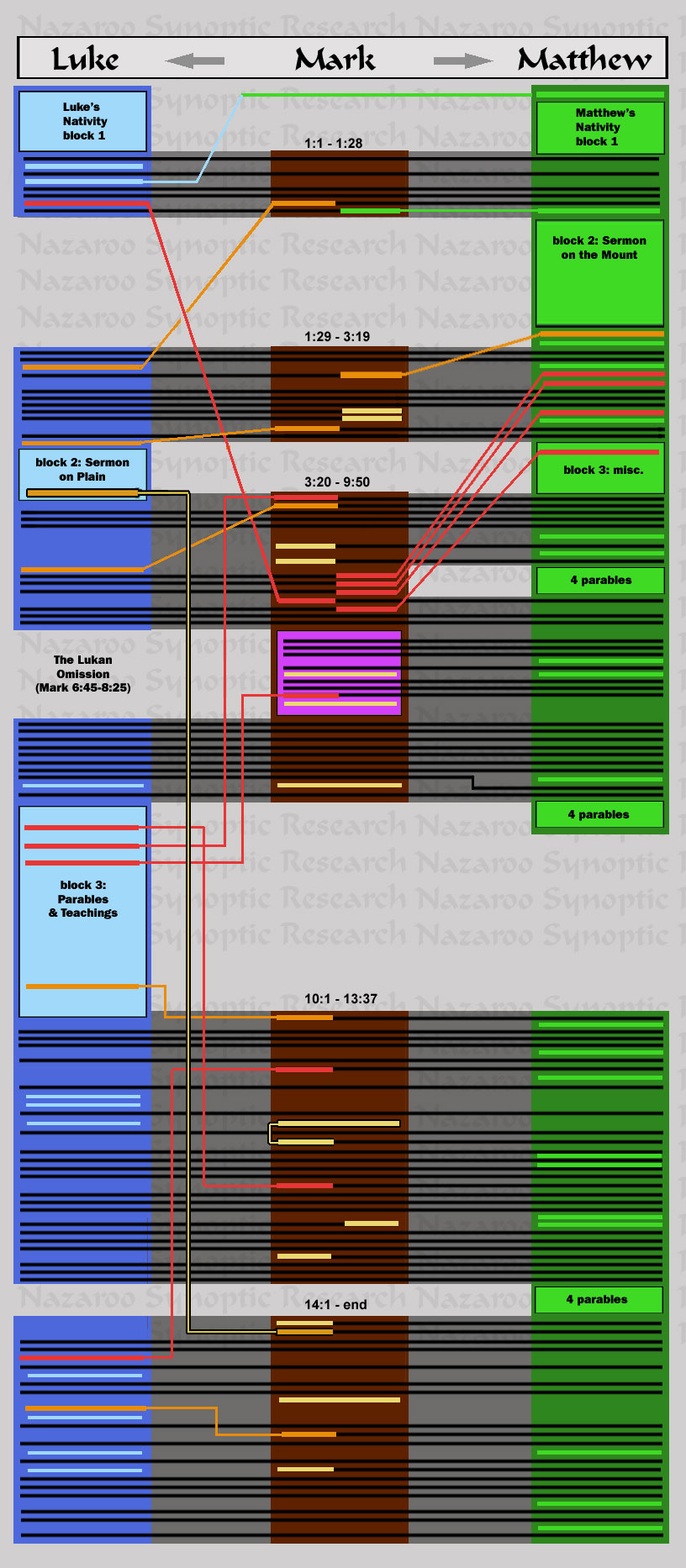Page Index
Last Updated: Sept. 28, 2007
Section 1: - Mark as a Base for Luke and Matthew
Section 2: - Luke & Matthew use Mark
Mark as a Base - block copying by Luke and Matthew
Sections Copied - analysis by sections
Minor Changes - additions, omissions, substitutions
The Big Picture - The full chart for Mark/Matthew
Section 3: - Analysis & Summary
INTRODUCTION
Mark as a Base for Luke and Matthew
The Synoptic Charts we have been using so far cannot show all the linguistic details that a section by section comparison can.
However, these Synoptic Charts are ideal for quickly and easily presenting the facts regarding both the basic content by section, and also the phenomena of the order of sections themselves. Lastly, the charts make clear just how strong the evidence for 'block-copying' between the evangelists is.
Remarkably, if we simply compare Luke to Matthew, and attempt to understand the alterations in the order of materials, we will quickly become dismayed. Even though Luke and Matthew virtually duplicate one another's material (even showing relationships in their substitution of materials), a one-to-one correspondance between them will quickly begin to look like spagetti, or the inside of a Bell telephone exchange.
Yet when Mark is admitted as the base used for both Luke and Matthew, it is stunning just how simple and organized the basic procedures of each later evangelist was.
(We will comment and explain the differences in order of materials between Luke and Matthew shortly).
Luke & Matthew Use Mark
Luke and Matthew Block-Copy Mark
In analyzing Matthew, we found a situation very similar to Luke, and even simpler:
Matthew also uses Mark as a base, breaks it up into relatively few pieces, and inserts his material in bulk in three large blocks (in slightly different places than Luke inserts his). In addition however, Matthew also inserts several small sections each made up of four parables or pericopes.
Block Copying
First lets have a look at the block-copying between the Synoptics. Here we have laid out the basic relationship in a standard synoptic chart form:
Block-Chart of Luke / Mark / Matthew

Matthew's Copying Procedure
The method of Matthew is even simpler than Luke (Matthew appears less creative, both in his organization of materials, and in his own special and unique sections.)
Yet is is obvious that both Luke and Matthew had a very similar plan, and one must have known of the other's method and agreed to use the same basic template.
Luke <-- Mark --> Matthew
Sections Copied
Again, we can get a clearer sense of the actual overlap and differences in each evangelist's use of Mark by noting the Markan sections line by line:

Minor Additions,
Omissions, Substitutions
Next we fill in the unique sections for each evangelist to get the picture on how these other materials are incorporated into each new gospel:
Main Lines,
Minor Add. Om. Subst.

The Big Picture
Final Chart:
Luke - Mark - Matthew
We now add in the sections that have been rearranged or dislocated from their original position in Mark. Here is the final chart for Luke / Mark / Matthew:
Luke / Mark / Matthew: Overview

Understanding the Direction of Dependance
Notice the power and clarity in arranging the three gospels this way. It is immediately apparent, how each evangelist used Mark, and how they differed in their final result.
We should stress how utterly implausible it would be for Mark to have used Matthew and Luke.
For Mark could not have achieved this remarkable harmony in the order of all the events he records, by simply copying alternating between Luke and Matthew, unless he knew them both inside-out, as to their chronological order.
But why would Mark preserve ONLY events that were chronologically in the same relative order between Matthew and Luke, while deleting all stories and events that were out of order?
We would have to assume that Mark rejected any and all sections that appeared out of order between Matthew and Luke. But this would be a ridiculous procedure. Why omit important details and teachings simply because Luke and Matthew (or just one of them) recorded those events out of order?
Nor could we explain how or why ALL those events which by circumstance happened to be in the same order between Matthew and Luke were thought by Mark to be important. There is no explanation.
The only sensible conclusion is to admit that Luke and Matthew independantly used Mark as a basis, preserving the order in Mark's account, while richly suppliimenting this gospel with new materials in their own way, yet at the same time using the same basic (and simple) plan.
Thus one of the last two, Matthew or Luke must have known of the procedure that the other one used. (It is not necessary for both to have been aware of the other's method.)
Analysis & Summary
Matthew's Special Uniqueness
Many may wonder what the basic evidence is for viewing Matthew as writing last.
Largely this evaluation of Matthew comes from internal evidence from Matthew itself, provided by the evangelist.
While not compelling, some obvious clues can be found in such statements by Matthew as:
'...and this saying is commonly reported among the Jews [Judaeans] unto this day.'
(Matt. 28:15b)
This statement seems to indicate that Matthew's gospel was written after a significant amount of time had passed between the events recorded, and date of its release.
The statement appears to have about the same function and impact as Luke's opening statement:
'...Many have undertaken to draw up an account of the things that have been fulfilled among us, just as they were handed down to us by those who from the first were eyewitnesses and servants of the word.'
(Luke 1:1fwd)
Here Luke also seems to imply a significant passage of time between his own writing and the actual events in his gospel. It seems reasonable to hold that both Luke and Matthew are near-contemporary, and one was written shortly after the other.
Other explanations could be offered for such narrative notes, for instance a later "revision" or final edition of Matthew. And this does not negate the possibility of an early Hebrew "Matthew" of some form, as indicated by some early traditions.
Yet whatever the contents of any early "Hebrew Matthew", the one we have to deal with is the one we actually have, namely our Greek Matthew.
Those evaluating the Gospels as we now have them must eventually deal in detail with the special contents of Matthew, which can at least help to establish a relative date and order of dependance between the Synoptics (Mark, Luke, and Matthew).
To assist in this evaluation of Matthew, there are a few pages on the internet that discuss these details.
For example, here are 4 pages on Matthew from Paul on Paul:
Matthew's Tendencies (1) - Jewishness .. Anti-Pharisaism
Matthew's Tendencies (2) - End-of-Time Expectation, Miracles
Matthew's Tendencies (3)-Christology, Idealization of the Apostles
Matthew's Tendencies (4) - Anecdotal Material, conclusions
Relationship between Luke and Matthew
We have previously warned the reader that Luke and Matthew diverge in quite an extreme manner among themselves regarding the order of their content, even though they reproduce 90% or more of the same materials.
Yet even this seeming chaos has a hidden deep pattern quite unexpected, which reveals the incredible plan of both evangelists.
But first we have to map out these interesting alterations in the order of events between Luke and Matthew, in order to understand their purpose.
